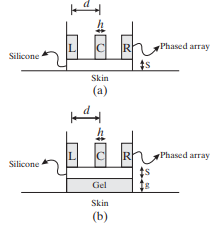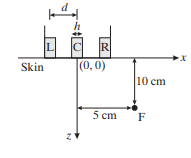A phased array ultrasound transducer consists of three elements (L,C,R) each of dimensions h = 3 mm and d = 8 mm, as shown in Figure P11.3. Each element has a square face, s(x, y) = rect![]() ). In the first scenario [Figure P11.3(a)], the transducer has a silicone sheet of thickness s = 2 mm on its front face, which is placed on the skin. The acoustic impedances Z and the speed of sound c in silicone and in skin are given in the table below. For parts (a) to (e), assume that only one element, C, is generating and receiving ultrasound waves. The envelope of the wave is ne(t) = rect
). In the first scenario [Figure P11.3(a)], the transducer has a silicone sheet of thickness s = 2 mm on its front face, which is placed on the skin. The acoustic impedances Z and the speed of sound c in silicone and in skin are given in the table below. For parts (a) to (e), assume that only one element, C, is generating and receiving ultrasound waves. The envelope of the wave is ne(t) = rect![]() and its frequency is 2 Mhz.
and its frequency is 2 Mhz.

(a) Sketch the A-mode signal from the time of the transmit pulse through the time of the echo from the silicone-skin interface. Assume a geometric field approximation and ignore attenuation and speckle. Clearly label key times and amplitudes.
In order to reduce the size of the echo from the skin, an acoustic gel of width g = 3 mm is introduced between the silicone and the skin, as shown in the figure [Figure P11.3(b)]. The gel is selected such that ![]()

(b) Find the speed of ultrasound in the gel, cgel, so that there can be no refraction at the gel-skin interface regardless of the angle of incidence.
(c) Sketch the A-mode signal from the time of the transmit pulse through the time of the echo from the gel-skin interface. Assume a geometric field approximation and ignore attenuation and speckle. Clearly label key times and amplitudes.
(d) Suppose you want your imaging system to be insensitive to the echo from the skin. What should the sensitivity L (in dB) be?

In parts (e) and (f) ignore the silicone and gel.
(e) Is point F in Figure P11.4 in the near field or far field of the central transducer?
(f) Find the time delays τL, τC, and τR so that, on transmit, the phased array will focus on the point F.

